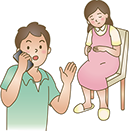Signs of Emergency Childbirth
- Very strong contractions approximately 2-3 minutes apart
- Water has broken
- Mother has strong urge to push down on the baby
- The woman says the birth will happen very soon
- A bit of blood running from the vagina
First Aid
- Call 911 or have someone else call and place their phone on speaker
- Take a few deep breaths and focus on the task ahead
- Allow the mother to decide which position is most comfortable for her
- Reassure the mother that help is on the way
If the baby's head is visible in the vaginal opening, birth is about to happen. DO NOT TRY TO ASSIST THE BABY.
The birth will happen naturally. Your role is to support the baby's head as it exits the vagina.
- Wash your hands and use disposable gloves if they are available.
- DO NOT pull on the baby's head. let the woman push the baby out.
- Support the baby's head. Be very careful because the baby will be slippery.
- With a clean cloth, gently wipe off the membrane covering from the mouth and nose.
- Give the baby to the mother. Do not remove the coating from the baby's body.
- Support the mother as she delivers the afterbirth. Keep the placenta and umbilical cord intact with the baby.
DO NOT CUT THE UMBILICAL CORD
While awaiting emergency services, keep the mother and baby safe and warm.
